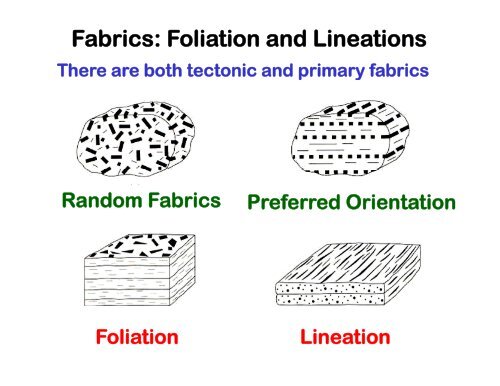Fabrics: Foliation and Lineations - Bryn Mawr College
Fabrics: Foliation and Lineations - Bryn Mawr College
Fabrics: Foliation and Lineations - Bryn Mawr College
Create successful ePaper yourself
Turn your PDF publications into a flip-book with our unique Google optimized e-Paper software.
<strong>Fabrics</strong>: <strong>Foliation</strong> <strong>and</strong> <strong>Lineations</strong><br />
There are both tectonic <strong>and</strong> primary fabrics<br />
R<strong>and</strong>om <strong>Fabrics</strong><br />
Preferred Orientation<br />
<strong>Foliation</strong><br />
Lineation
Tectonites<br />
Rocks with a penetrative ti tectonic t fabric<br />
L-tectonite: t fabric dominated d by a tectonic t lineation<br />
S-tectonite: fabric dominated by a tectonic<br />
foliation<br />
LS-tectonite: general term for a rock with<br />
both a foliation <strong>and</strong> a lineation<br />
LS-tectonite: lineation stronger<br />
SL-tectonite: foliation stronger
Tectonic <strong>Foliation</strong>
Cleavage Classification<br />
{Compositional
Spaced Cleavage
Disjunctive <strong>Foliation</strong>
Pencil Cleavage
Continuous <strong>Fabrics</strong><br />
All minerals flattened or rotated t into parallelism<br />
li
Continuous <strong>Fabrics</strong><br />
All minerals flattened or rotated t into parallelism<br />
li
Continuous <strong>Fabrics</strong><br />
Coarse<br />
Fine
Slaty Cleavage
Slaty Cleavage Formation ~ 250-350 o C
Phyllitic Cleavage ~ Lower Greenschist facies
Phyllitic Cleavage <strong>and</strong> Schistosity ~ greenschist facies
Phyllite
Shistosity ~ middle greenschist facies
Axial Planar Cleavage
Fanned Cleavage<br />
• Early Layer Parallel Shortening<br />
Cleavage<br />
Refraction<br />
• Cleavage Perpendicular to Bedding
Cleavage Refraction
Bedding<br />
steeper than<br />
cleavage<br />
Cleavage<br />
steeper than<br />
bedding
Crenulation Cleavage
Crenulation Cleavage
How <strong>Foliation</strong>s Develop<br />
1. Mechanical flattening of grains
How <strong>Foliation</strong>s Develop<br />
1. Mechanical flattening of grains<br />
dissolution<br />
reprecipitation<br />
Riecke’s Principle
How <strong>Foliation</strong>s Develop<br />
1. Mechanically flattening grains
How <strong>Foliation</strong>s Develop<br />
2. Rotation<br />
ti
How <strong>Foliation</strong>s Develop<br />
3. Crystallization
How <strong>Foliation</strong>s Develop<br />
4. Transposition
How <strong>Foliation</strong>s Develop<br />
4. Transposition
Differentiated layering<br />
5. Inheritance of layered fabric<br />
Gneissic B<strong>and</strong>ing
6. Pressure-solution cleavage
Disjunctive<br />
Cleavage Formation
Disjunctive cleavage spacing is a function of initial clay content
<strong>Lineations</strong>
1. Slickensides<br />
fibrous<br />
grooves
2. Fold lineation
3. Intersection Lineation
4. Mineral <strong>Lineations</strong><br />
elongate grains
4. Mineral <strong>Lineations</strong><br />
lineation <strong>and</strong><br />
foliation<br />
just a lineation<br />
tabular grains e.g. feldspars
5. Other Markers<br />
e.g. pebbles, fossils
5. Other Markers<br />
e.g. reduction spots, ooids, burrows, etc.
5. Other Markers<br />
oblate particles<br />
foliation only
5. Other Markers<br />
prolate particles<br />
lineation or foliation but not both
6. Boudins
6. Boudins
6. Boudins
6. Boudins
7. Mullions
















